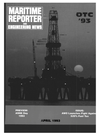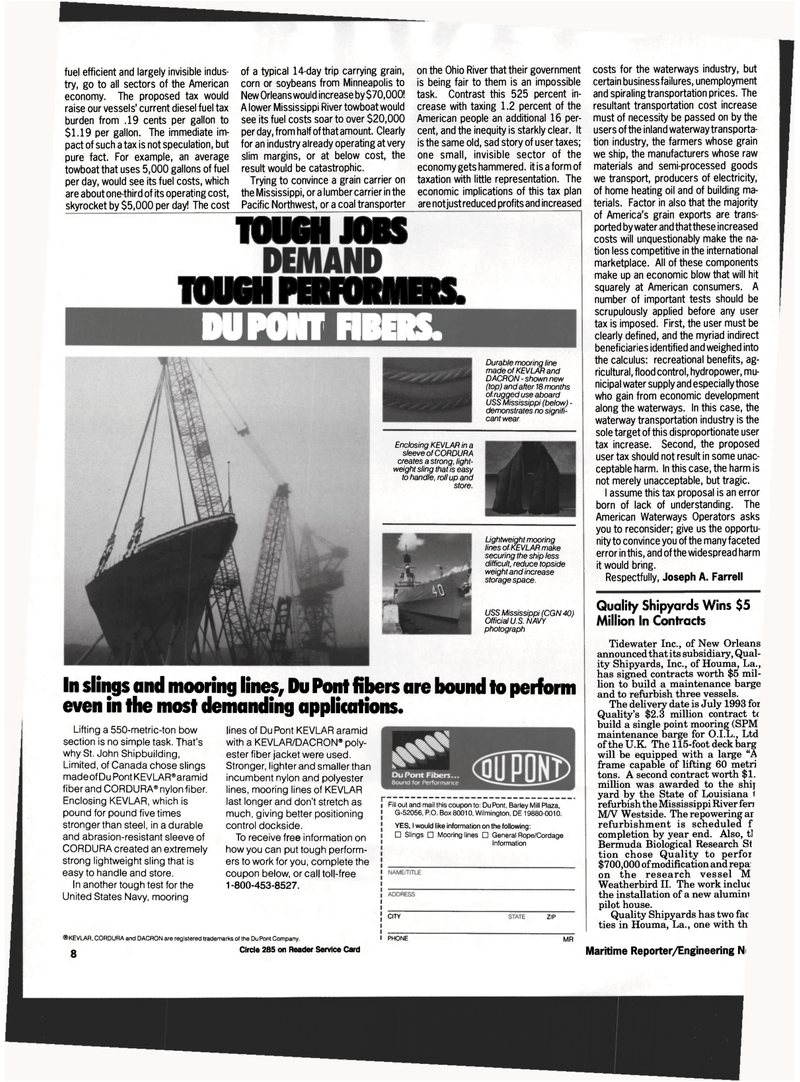
Page 6: of Maritime Reporter Magazine (April 1993)
Read this page in Pdf, Flash or Html5 edition of April 1993 Maritime Reporter Magazine
fuel efficient and largely invisible indus- try, go to all sectors of the American economy. The proposed tax would raise our vessels' current diesel fuel tax burden from .19 cents per gallon to $1.19 per gallon. The immediate im- pact of such a tax is not speculation, but pure fact. For example, an average towboat that uses 5,000 gallons of fuel per day, would see its fuel costs, which are about one-third of its operating cost, skyrocket by $5,000 per day! The cost of a typical 14-day trip carrying grain, corn or soybeans from Minneapolis to
New Orleans would increase by $70,000!
A lower Mississippi River towboat would see its fuel costs soar to over $20,000 per day, from half of that amount. Clearly for an industry already operating at very slim margins, or at below cost, the result would be catastrophic.
Trying to convince a grain carrier on the Mississippi, or a lumber carrier in the
Pacific Northwest, or a coal transporter on the Ohio River that their government is being fair to them is an impossible task. Contrast this 525 percent in- crease with taxing 1.2 percent of the
American people an additional 16 per- cent, and the inequity is starkly clear. It is the same old, sad story of user taxes; one small, invisible sector of the economy gets hammered, it is a form of taxation with little representation. The economic implications of this tax plan are not just reduced profits and increased
TOUGH JOBS
TOUGH PERFORMERS.
DU PONT FIBERS.
Enclosing KEVLAR in a sleeve of CORDURA creates a strong, light- weight sling that is easy to handle, roll up and store.
Durable mooring line made of KEVLAR and
DACRON - shown new (top) and after 18 months of rugged use aboard
USS Mississippi (below) - demonstrates no signifi- cant wear.
Lightweight mooring lines of KEVLAR make securing the ship less difficult, reduce topside weight and increase storage space.
USS Mississippi (CGN 40)
Official U.S. NAVY photograph
In slings and mooring lines, Du Pont fibers are bound to perform even in the most demanding applications.
Lifting a 550-metric-ton bow section is no simple task. That's why St. John Shipbuilding,
Limited, of Canada chose slings madeof Du PontKEVLAR®aramid fiberand CORDURA®nylon fiber.
Enclosing KEVLAR, which is pound for pound five times stronger than steel, in a durable and abrasion-resistant sleeve of
CORDURA created an extremely strong lightweight sling that is easy to handle and store.
In another tough test for the
United States Navy, mooring lines of Du Pont KEVLAR aramid with a KEVLAR/DACRON® poly- ester fiber jacket were used.
Stronger, lighter and smaller than incumbent nylon and polyester lines, mooring lines of KEVLAR last longer and don't stretch as much, giving better positioning control dockside.
To receive free information on how you can put tough perform- ers to work for you, complete the coupon below, or call toll-free 1-800-453-8527. ® KEVLAR, CORDURA and DACRON are registered trademarks of the Du Pont Company. g Circle 285 on Reader Service Card
Fill out and mail this coupon to: Du Pont, Barley Mill Plaza,
G-52056, P.O. Box 80010, Wilmington, DE 19880-0010.
YES, I would like information on the following: • Slings • Mooring lines • General Rope/Cordage
Information
CITY ZIP
PHONE MR costs for the waterways industry, but certain businessfailures, unemployment and spiraling transportation prices. The resultant transportation cost increase must of necessity be passed on by the users of the inland waterway transporta- tion industry, the farmers whose grain we ship, the manufacturers whose raw materials and semi-processed goods we transport, producers of electricity, of home heating oil and of building ma- terials. Factor in also that the majority of America's grain exports are trans- ported by water and that these increased costs will unquestionably make the na- tion less competitive in the international marketplace. All of these components make up an economic blow that will hit squarely at American consumers. A number of important tests should be scrupulously applied before any user tax is imposed. First, the user must be clearly defined, and the myriad indirect beneficiaries identified and weighed into the calculus: recreational benefits, ag- ricultural, flood control, hydropower, mu- nicipal water supply and especially those who gain from economic development along the waterways. In this case, the waterway transportation industry is the sole target of this disproportionate user tax increase. Second, the proposed user tax should not result in some unac- ceptable harm. In this case, the harm is not merely unacceptable, but tragic.
I assume this tax proposal is an error born of lack of understanding. The
American Waterways Operators asks you to reconsider; give us the opportu- nity to convince you of the many faceted error in this, and of the widespread harm it would bring.
Respectfully, Joseph A. Farrell
Quality Shipyards Wins $5
Million In Contracts
Tidewater Inc., of New Orleans announced that its subsidiary, Qual- ity Shipyards, Inc., of Houma, La., has signed contracts worth $5 mil- lion to build a maintenance barge and to refurbish three vessels.
The delivery date is July 1993 foi
Quality's $2.3 million contract tc build a single point mooring (SPM maintenance barge for O.I.L., Ltd of the U.K. The 115-foot deck barg will be equipped with a large "A frame capable of lifting 60 metri tons. A second contract worth $1. million was awarded to the shij yard by the State of Louisiana 1 refurbish the Mississippi River fen
M/V Westside. The repowering ar refurbishment is scheduled f completion by year end. Also, tl
Bermuda Biological Research St tion chose Quality to perfoi $700,000 of modification and repa: on the research vessel M
Weatherbird II. The work incluc the installation of a new alumini pilot house.
Quality Shipyards has two fac ties in Houma, La., one with th 8 Maritime Reporter/Engineering News

 5
5

 7
7
